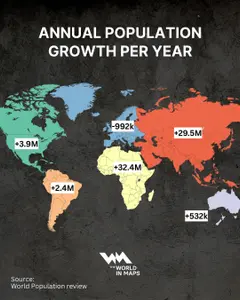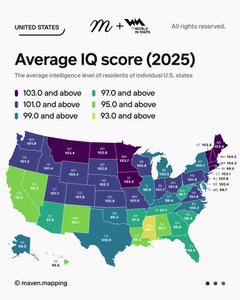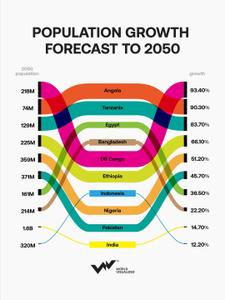demographics

Environment / 3 weeks ago
Muslims in Europe are having more children than non-Muslims
Across Europe, birth rates tell a changing story. According to new findings from the Pew Research Center, Muslim families are having more children on average than non-Muslims, a pattern that is reshaping the region’s population dynamics. From 2015 to 2020, Muslim women in countries like Finland recorded an average of 3.1 children per woman, compared to 1.7 among non-Muslims.

World / 3 weeks ago
5 of the world’s 10 largest countries now below replacement-level fertility
Across much of the world, people are having fewer children than ever before. A new visual from World Visualised, using World Bank data, shows a striking pattern: between 2000 and 2023, fertility rates in the ten largest countries have fallen sharply, and in five of them, they’ve dropped below the replacement level of 2.1 births per woman. According to the data, this includes China, Russia, the United States, Brazil, and Indonesia, nations that together make up nearly half of the world’s population. Meanwhile, countries like Nigeria, Ethiopia, Pakistan, Bangladesh, and India have also seen steady declines, though their rates remain above replacement for now.

World / 4 weeks ago
Africa leads the world in population growth as Europe shrinks
The world’s population is still growing, but not evenly. According to the World Population Review, Africa is adding about 32.4 million people every year, making it the fastest-growing continent on Earth. Asia follows closely, increasing by around 29.5 million people per year. In contrast, Europe’s population is shrinking, losing nearly one million people annually.

Culture / 5 weeks ago
What the new IQ map really tells us about America
A new map ranking the average IQ scores of U.S. states in 2025 has reignited the national conversation about intelligence, education, and opportunity in America. Created by Maven Mapping in collaboration with The World in Maps, the visualisation claims to show how the average cognitive scores of residents vary across the country, but experts urge caution before drawing sweeping conclusions.

World / 6 weeks ago
Why some nations have more men and others more women
A world map produced by The World in Maps tellingly shades nations by whether they have more men or more women — red where women are in the majority, blue where men outnumber women. Globally, as of 2025, there are about 101.07 males for every 100 females in the world population. That slight male majority is driven largely by higher birth ratios favouring boys, though over time that tilt tends to fade as women live longer on average.

World / 10 weeks ago
Africa set to power global population growth as world nears 10 billion
The world’s demographic map is changing rapidly, and the shift is most visible in Africa. Several African countries are set to experience extraordinary population growth by 2050, while other regions of the world will expand more slowly or even begin to decline. The United Nations’ World Population Prospects 2024 projects that the global population will climb from around 8.16 billion in 2024 to 9.66 billion by 2050.

Maps / 11 weeks ago
Ireland vs South Korea: Two countries that look alike on the map but different
An infographic from The World in Maps overlays the outline of Ireland on the Korean Peninsula, showing how the two countries have remarkably similar north–south silhouettes. Beyond their shapes, however, South Korea and Ireland diverge sharply in terms of geography, population, and economy. South Korea spans about 100,222 km² and has around 51.2 million people (2025), ranking as the world’s 29th‑most‑populous country. Ireland covers roughly 69,947 km² and has 5.34 million residents.

Maps / 11 weeks ago
Africa’s religious divide: Map reveals a Muslim north, a Christian south and one Hindu-majority state
Across North Africa and parts of the Sahel, Islam dominates; most of central and southern Africa is majority Christian; and only Mauritius, an island in the Indian Ocean, is predominantly Hindu. Islam first reached Africa in the seventh century when the Umayyad and Abbasid caliphates spread the faith across the northern edge of the continent. Over time, Muslim kingdoms and trans-Saharan trade networks entrenched Islam across North and West Africa.

Maps / 14 weeks ago



